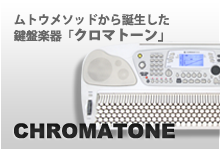3 line notation (Chromatic notation)
Muto Notation Method that naturally strengthens sense of pitch
Chromatic Notation
You need to train yourself for long time to be able to 5 line notation smoothly. Because it has uses complicated signs like ciphers and structural problems like difficulty in to grasp distance between notes. It has been contradictory that the more you learn 5 line notation, the more you lose sense of pitch. We solve the problems and contradictions of 5 line notations to let music much easier to understand with Muto Music Method. And we came up with new music notation called Chromatic Notation. As 1 octave is indicated with 3 basic lines, it is called ‘3 line notation’ compared to 5 line notation or ‘Muto Notation’.
You can use Muto Notation (Chromatic Notation) rationally in all different music scenes such as string instruments like guitar and violin, transposing instruments, singing, music education, in addition to keyboards like piano.
The notation that shows 1 octave with 3 base lines.
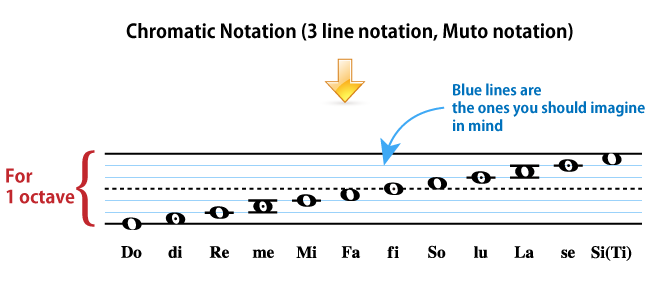
3 line notation indicates music with 3 lines while 5 line notation indicates with 5 solid lines. From the lower solid line to upper solid line covers 1 octave.
("C = Do", "C♯ / D♭ = di", "D = Re", "D♯ / E♭ = me", "E = Mi", "F = Fa", "F♯ / G♭ = fi", "G = So", "G♯ / A♭ = lu", "A = La", "A♯ / B♭ = Se", "B = Si")
Both solid lines (top and bottom) are ‘DO’. Dotted line in the middle is Fa# "Fi". For convenience of the readers to understand, the diagram above has 2 blue lines each between 3 lines. But in reality, blue lines should be imagined in mind. This realizes the mechanism that indicates all the notes in the 12 scales without using # and ♭.
As the positions for all 12 notes are set up, the way to indicate notes remains same after key changes. If same melody is lowered by 1 octave, the position of note indicated and the distance between notes do not change. In other words, you can grasp the distance between notes that make chord correctly a glance.
The less the numbers of lines are, the more instinctively you can read the distance between lines. If the numbers of lines are 2, it is hard to grasp the distance in the middle part. If the numbers of lines are 7, it is difficult to read as it gets busy. In that sense, 5 lines of 5 line notation is easy to tell. But 3 lines of ‘Chromatic Notation (3 line notation)’ is even easier to read than the case of 5 line notation. Thanks to less numbers of lines, it makes easy to be read at first time. You can get to know which note is at a brief look at notation.
Also Chromatic Notation does not use # and ♭at all.

In the case of Chromatic Notation, the note in that position is always same note. Therefore, once you memorize the positions as ‘the picture of notes’, even small child can read notation in one hour or two.
Moreover, it is a big advantage that the notation itself has the form of fingers touching keyboard in Chromatic Notation (see the diagram below).
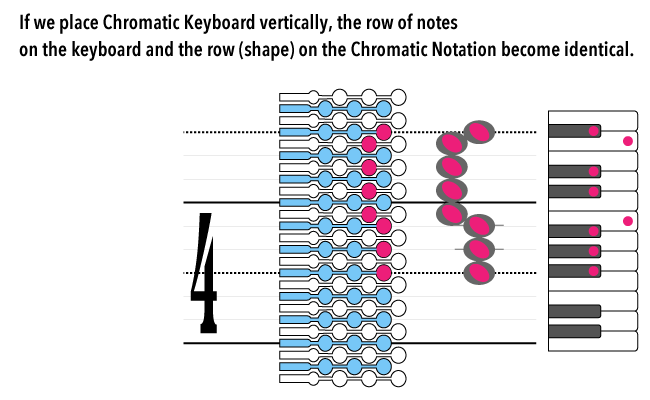
As you can grasp the distance between notes by sight in Chromatic Notation, you can improve the sense of pitch unconsciously, that is epoch making. In the viewpoint of education, it must be very significant notation method.
In the next section, we are going to briefly explain the mechanism of Chromatic Notation and how to read it.
The 5 characteristics and mechanism, how to read of Chromatic Notation (3 line notation) , the latest notation method
New notation method, Chromatic Notation (3 line notation) does not use chromatic signs such as # and ♭ and clefs. You just memorize the 12 types of pictures. You can learn it in the short amount of time as it is simple, and you can read notation instinctively.
Here we introduce how to read Chromatic Notation.
Characteristic 1: No chromatic signs like # and ♭!
Chromatic Notation does not require any chromatic signs like # and ♭ in any keys .

Characteristic 2: No Clef !
In Chromatic Notation, the numbers are used instead of clefs. These numbers are used to show the range of notes. And in any ranges, all the notes on the solid lines are ‘DO’.
For example, in the domain of G clef of piano, ‘DO, RE, MI, FA, SO, LA, SI, (DO)’ starting from DO of center position, is 4. We have 1 for the lowest octave to 7 that is highest octave.
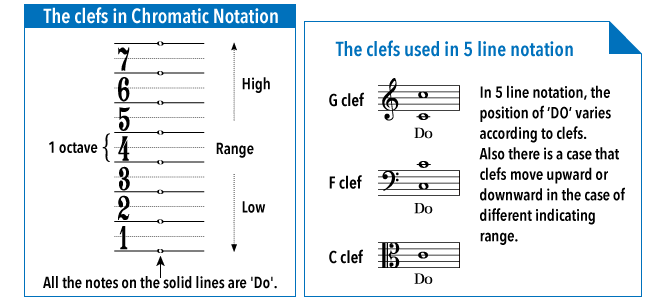
Also, it does not happen the things like the scale changes when the clefs change.
Characteristic 3: We named notes of black keys !
We named notes of black keys that had no name.
With these, you can read 12 notes smoothly and you can learn sense of pitch and music theory efficiently.

Characteristic 4: If you can read 1 octave, it’s OK !
You can read a note as same even in the high range or in the low range.
You just need to memorize the 12 types of pictures of notes. Then you will be able to read notation simply and instinctively.
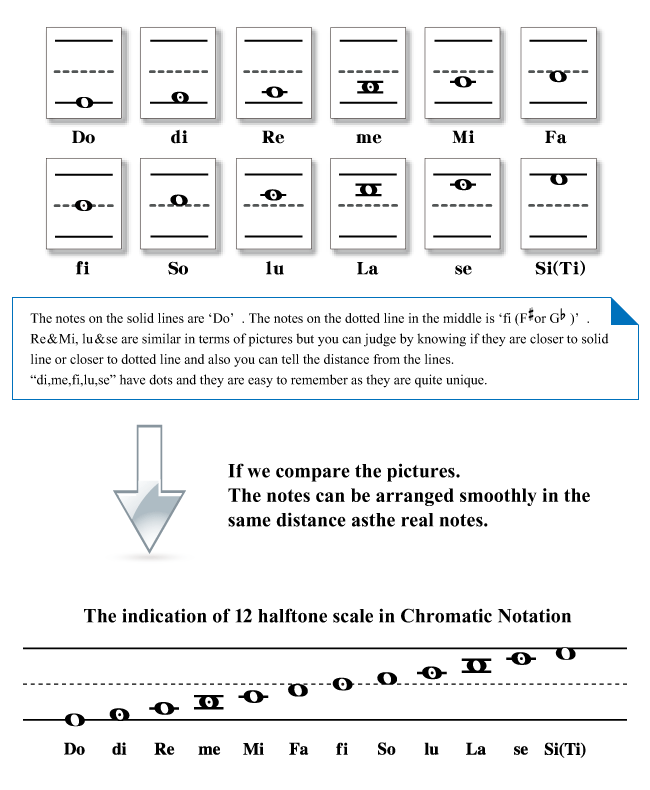
If you memorize the notes in 1 octave, you can apply to any range easily. The solid lines on the top and at the bottom show ‘DO’. Also 3 lines added each on the upper part and lower part, now it becomes easier to indicate high and low range (see the diagram below).

Characteristic 5: The distance between notes are correctly matched both in terms of sight and hearing !
Characteristic 5: The distance between notes are correctly matched both in terms of sight and hearing !
Chromatic Notation is correct music map.
The distance between one note and another note in the notation (sight) and The distance between one note and another note in the real sound (hearing) are perfectly matched.
5 line music notation
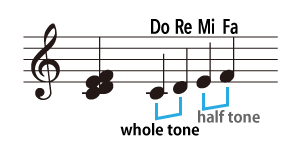
If we look at DO, RE, MI, FA in 5 line music notation, as the 4 notes are line up in the same distance, we tend to feel the distances
Chromatic notation
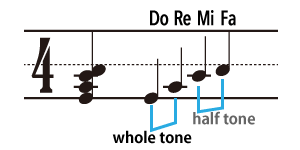
Then how about Muto Music Notation Method (= Chromatic Notation) ? It shows the distance of ‘DO&RE’ as twice as big as ‘MI&FA’.
As <sense of hearing> with your ears and
Now let’s look at the chord in 5 line notation (See diagram on the left).
5 line music notation
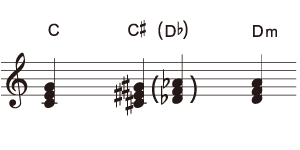
‘C’ and ‘C# (or D♭) are the same Major Chord.
On the other hand, ‘Dm’ is other type of chord minor chord, but it is hard to tell at a glance in the 5 line notation.
Chromatic notation
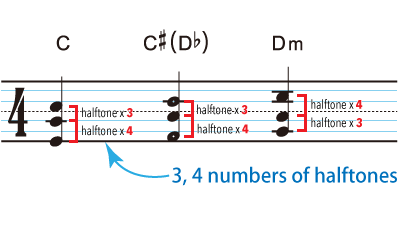
In 3 line notation (= Chromatic Notation), we can see ‘C’ and ‘C#’ are the same type of Major Chord , just sliding the notes. But as ‘Dm’ is Minor Chord, we can know that it is different type of chord from ‘C’ by looking at the distance of the notes. Muto Music Notation Method (= Chromatic Notation) enabled us to read the type




